Health Policy Brief: Medication Management in Residential Care Sector
VerifiedAdded on 2023/01/05
|13
|3094
|97
Report
AI Summary
This report provides an in-depth analysis of the Australian government's health policy concerning medication management in residential care facilities. The paper begins with an executive summary, followed by a critique of the policy brief. It examines the background of the health policy, its rationale, and the challenges associated with its implementation, such as stakeholder conflicts, data availability, and communication barriers. The analysis identifies potential options for decision-makers, including the selection of appropriate stakeholders and conducting needs assessments. The report recommends improvements to the policy, like gathering more data on adverse events and establishing a medication advisory board. The paper emphasizes the importance of clear communication, the use of technology and the need for ensuring staff competence. The report highlights the significance of the policy in addressing medication safety issues within residential aged care settings, including the need for a holistic approach that involves the residents, healthcare workers, and the government.

Running head:HEALTH POLICY AND PLANNING
HEALTH POLICY AND PLANNING
Name of the Student
Name of the university
Author’s note
HEALTH POLICY AND PLANNING
Name of the Student
Name of the university
Author’s note
Paraphrase This Document
Need a fresh take? Get an instant paraphrase of this document with our AI Paraphraser
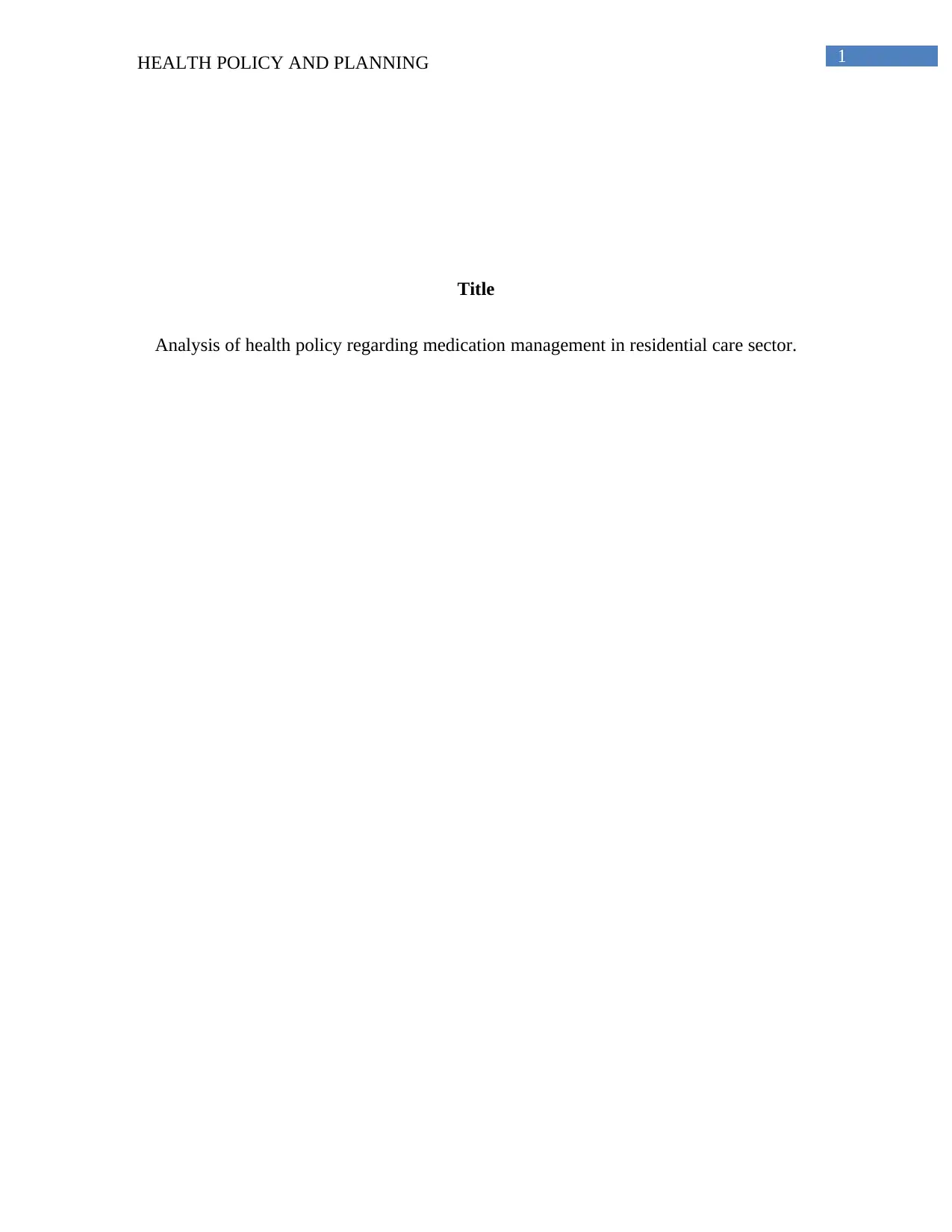
1HEALTH POLICY AND PLANNING
Title
Analysis of health policy regarding medication management in residential care sector.
Title
Analysis of health policy regarding medication management in residential care sector.
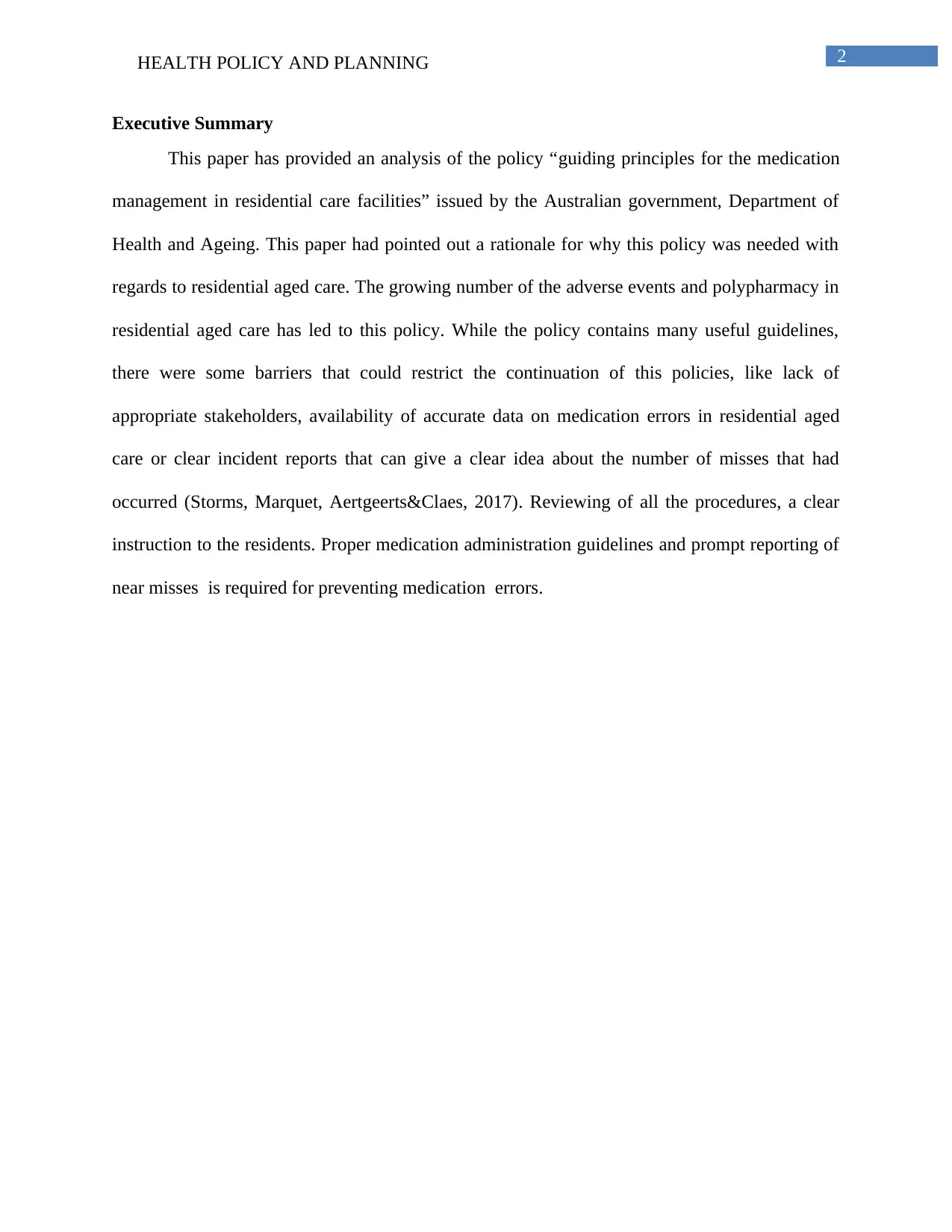
2HEALTH POLICY AND PLANNING
Executive Summary
This paper has provided an analysis of the policy “guiding principles for the medication
management in residential care facilities” issued by the Australian government, Department of
Health and Ageing. This paper had pointed out a rationale for why this policy was needed with
regards to residential aged care. The growing number of the adverse events and polypharmacy in
residential aged care has led to this policy. While the policy contains many useful guidelines,
there were some barriers that could restrict the continuation of this policies, like lack of
appropriate stakeholders, availability of accurate data on medication errors in residential aged
care or clear incident reports that can give a clear idea about the number of misses that had
occurred (Storms, Marquet, Aertgeerts&Claes, 2017). Reviewing of all the procedures, a clear
instruction to the residents. Proper medication administration guidelines and prompt reporting of
near misses is required for preventing medication errors.
Executive Summary
This paper has provided an analysis of the policy “guiding principles for the medication
management in residential care facilities” issued by the Australian government, Department of
Health and Ageing. This paper had pointed out a rationale for why this policy was needed with
regards to residential aged care. The growing number of the adverse events and polypharmacy in
residential aged care has led to this policy. While the policy contains many useful guidelines,
there were some barriers that could restrict the continuation of this policies, like lack of
appropriate stakeholders, availability of accurate data on medication errors in residential aged
care or clear incident reports that can give a clear idea about the number of misses that had
occurred (Storms, Marquet, Aertgeerts&Claes, 2017). Reviewing of all the procedures, a clear
instruction to the residents. Proper medication administration guidelines and prompt reporting of
near misses is required for preventing medication errors.
⊘ This is a preview!⊘
Do you want full access?
Subscribe today to unlock all pages.

Trusted by 1+ million students worldwide
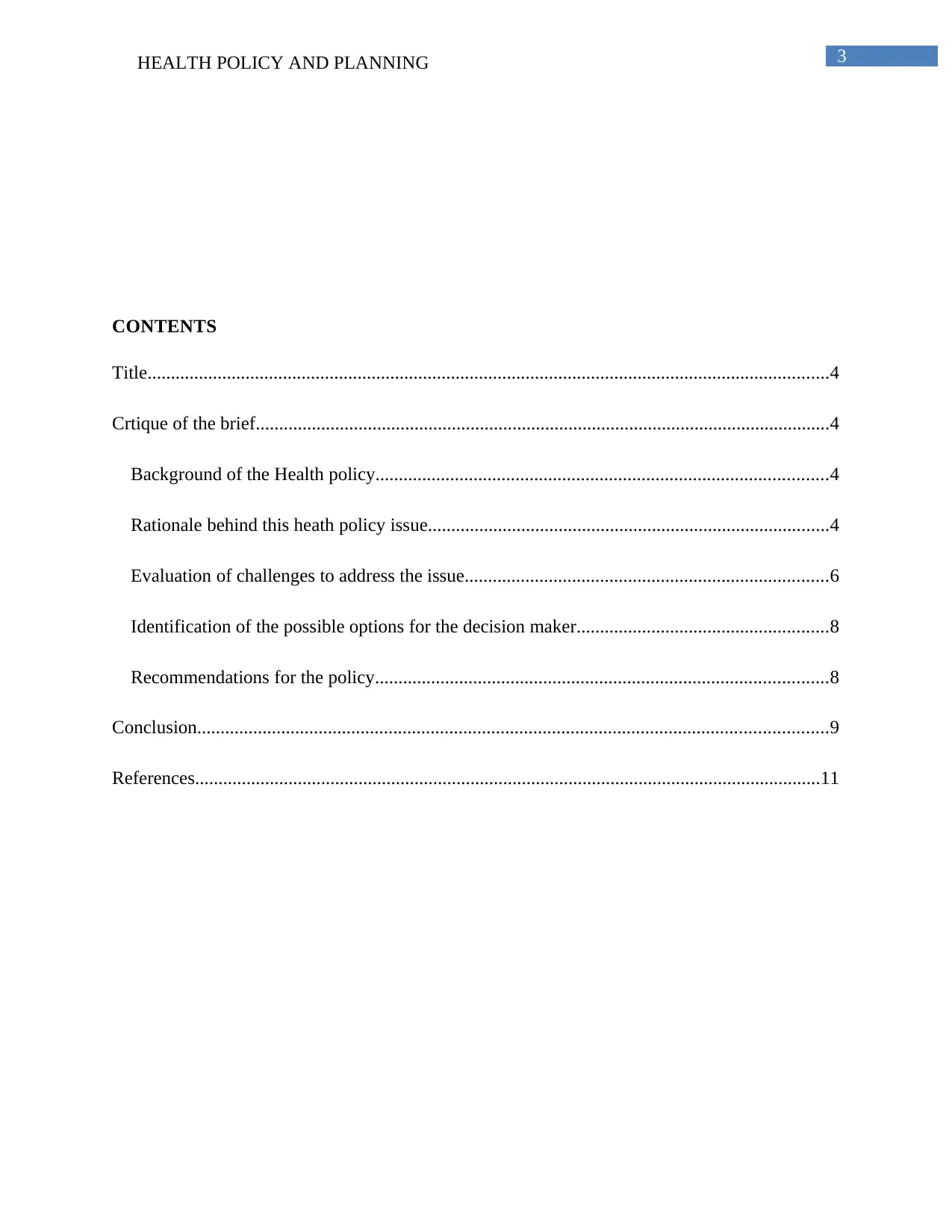
3HEALTH POLICY AND PLANNING
CONTENTS
Title..................................................................................................................................................4
Crtique of the brief...........................................................................................................................4
Background of the Health policy.................................................................................................4
Rationale behind this heath policy issue......................................................................................4
Evaluation of challenges to address the issue..............................................................................6
Identification of the possible options for the decision maker......................................................8
Recommendations for the policy.................................................................................................8
Conclusion.......................................................................................................................................9
References......................................................................................................................................11
CONTENTS
Title..................................................................................................................................................4
Crtique of the brief...........................................................................................................................4
Background of the Health policy.................................................................................................4
Rationale behind this heath policy issue......................................................................................4
Evaluation of challenges to address the issue..............................................................................6
Identification of the possible options for the decision maker......................................................8
Recommendations for the policy.................................................................................................8
Conclusion.......................................................................................................................................9
References......................................................................................................................................11
Paraphrase This Document
Need a fresh take? Get an instant paraphrase of this document with our AI Paraphraser
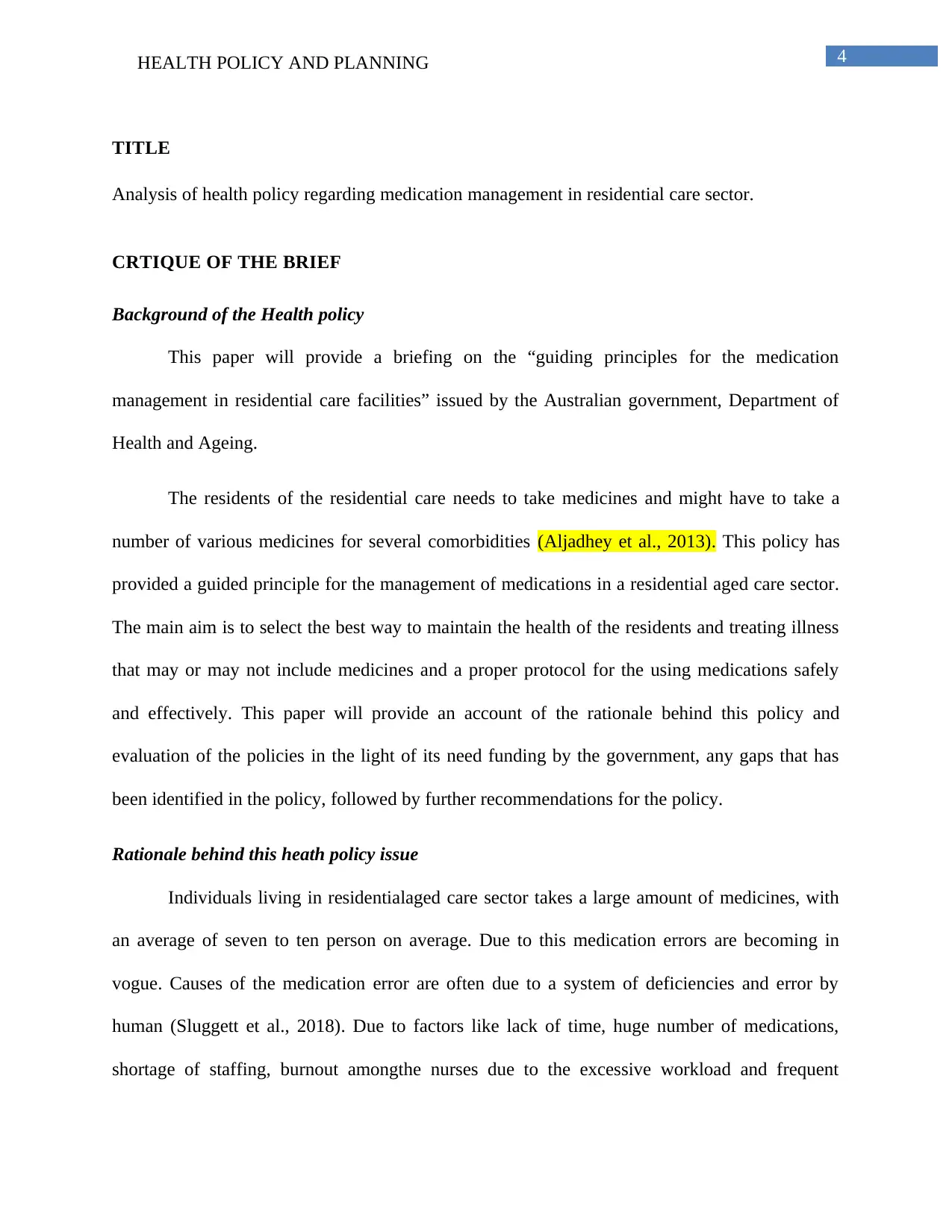
4HEALTH POLICY AND PLANNING
TITLE
Analysis of health policy regarding medication management in residential care sector.
CRTIQUE OF THE BRIEF
Background of the Health policy
This paper will provide a briefing on the “guiding principles for the medication
management in residential care facilities” issued by the Australian government, Department of
Health and Ageing.
The residents of the residential care needs to take medicines and might have to take a
number of various medicines for several comorbidities (Aljadhey et al., 2013). This policy has
provided a guided principle for the management of medications in a residential aged care sector.
The main aim is to select the best way to maintain the health of the residents and treating illness
that may or may not include medicines and a proper protocol for the using medications safely
and effectively. This paper will provide an account of the rationale behind this policy and
evaluation of the policies in the light of its need funding by the government, any gaps that has
been identified in the policy, followed by further recommendations for the policy.
Rationale behind this heath policy issue
Individuals living in residentialaged care sector takes a large amount of medicines, with
an average of seven to ten person on average. Due to this medication errors are becoming in
vogue. Causes of the medication error are often due to a system of deficiencies and error by
human (Sluggett et al., 2018). Due to factors like lack of time, huge number of medications,
shortage of staffing, burnout amongthe nurses due to the excessive workload and frequent
TITLE
Analysis of health policy regarding medication management in residential care sector.
CRTIQUE OF THE BRIEF
Background of the Health policy
This paper will provide a briefing on the “guiding principles for the medication
management in residential care facilities” issued by the Australian government, Department of
Health and Ageing.
The residents of the residential care needs to take medicines and might have to take a
number of various medicines for several comorbidities (Aljadhey et al., 2013). This policy has
provided a guided principle for the management of medications in a residential aged care sector.
The main aim is to select the best way to maintain the health of the residents and treating illness
that may or may not include medicines and a proper protocol for the using medications safely
and effectively. This paper will provide an account of the rationale behind this policy and
evaluation of the policies in the light of its need funding by the government, any gaps that has
been identified in the policy, followed by further recommendations for the policy.
Rationale behind this heath policy issue
Individuals living in residentialaged care sector takes a large amount of medicines, with
an average of seven to ten person on average. Due to this medication errors are becoming in
vogue. Causes of the medication error are often due to a system of deficiencies and error by
human (Sluggett et al., 2018). Due to factors like lack of time, huge number of medications,
shortage of staffing, burnout amongthe nurses due to the excessive workload and frequent
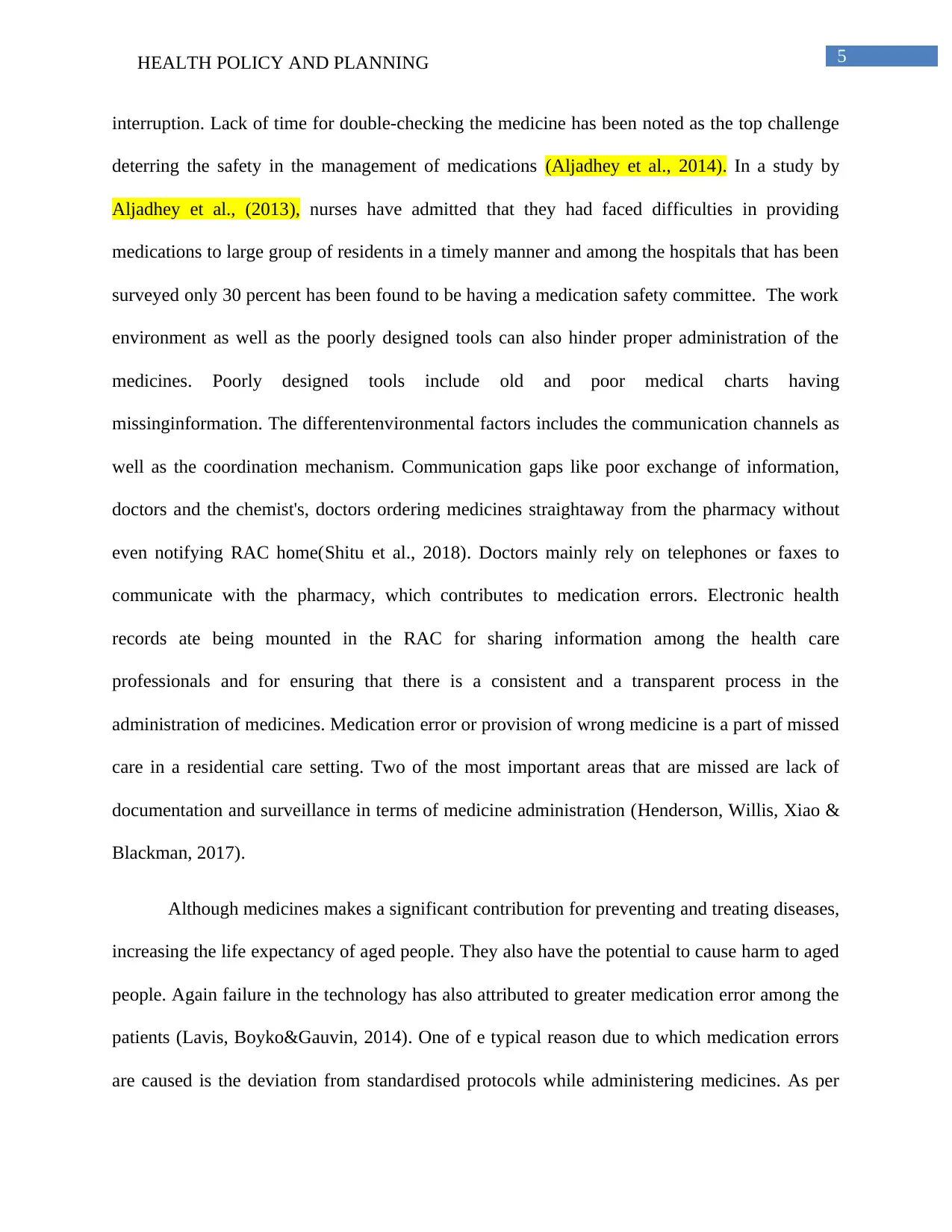
5HEALTH POLICY AND PLANNING
interruption. Lack of time for double-checking the medicine has been noted as the top challenge
deterring the safety in the management of medications (Aljadhey et al., 2014). In a study by
Aljadhey et al., (2013), nurses have admitted that they had faced difficulties in providing
medications to large group of residents in a timely manner and among the hospitals that has been
surveyed only 30 percent has been found to be having a medication safety committee. The work
environment as well as the poorly designed tools can also hinder proper administration of the
medicines. Poorly designed tools include old and poor medical charts having
missinginformation. The differentenvironmental factors includes the communication channels as
well as the coordination mechanism. Communication gaps like poor exchange of information,
doctors and the chemist's, doctors ordering medicines straightaway from the pharmacy without
even notifying RAC home(Shitu et al., 2018). Doctors mainly rely on telephones or faxes to
communicate with the pharmacy, which contributes to medication errors. Electronic health
records ate being mounted in the RAC for sharing information among the health care
professionals and for ensuring that there is a consistent and a transparent process in the
administration of medicines. Medication error or provision of wrong medicine is a part of missed
care in a residential care setting. Two of the most important areas that are missed are lack of
documentation and surveillance in terms of medicine administration (Henderson, Willis, Xiao &
Blackman, 2017).
Although medicines makes a significant contribution for preventing and treating diseases,
increasing the life expectancy of aged people. They also have the potential to cause harm to aged
people. Again failure in the technology has also attributed to greater medication error among the
patients (Lavis, Boyko&Gauvin, 2014). One of e typical reason due to which medication errors
are caused is the deviation from standardised protocols while administering medicines. As per
interruption. Lack of time for double-checking the medicine has been noted as the top challenge
deterring the safety in the management of medications (Aljadhey et al., 2014). In a study by
Aljadhey et al., (2013), nurses have admitted that they had faced difficulties in providing
medications to large group of residents in a timely manner and among the hospitals that has been
surveyed only 30 percent has been found to be having a medication safety committee. The work
environment as well as the poorly designed tools can also hinder proper administration of the
medicines. Poorly designed tools include old and poor medical charts having
missinginformation. The differentenvironmental factors includes the communication channels as
well as the coordination mechanism. Communication gaps like poor exchange of information,
doctors and the chemist's, doctors ordering medicines straightaway from the pharmacy without
even notifying RAC home(Shitu et al., 2018). Doctors mainly rely on telephones or faxes to
communicate with the pharmacy, which contributes to medication errors. Electronic health
records ate being mounted in the RAC for sharing information among the health care
professionals and for ensuring that there is a consistent and a transparent process in the
administration of medicines. Medication error or provision of wrong medicine is a part of missed
care in a residential care setting. Two of the most important areas that are missed are lack of
documentation and surveillance in terms of medicine administration (Henderson, Willis, Xiao &
Blackman, 2017).
Although medicines makes a significant contribution for preventing and treating diseases,
increasing the life expectancy of aged people. They also have the potential to cause harm to aged
people. Again failure in the technology has also attributed to greater medication error among the
patients (Lavis, Boyko&Gauvin, 2014). One of e typical reason due to which medication errors
are caused is the deviation from standardised protocols while administering medicines. As per
⊘ This is a preview!⊘
Do you want full access?
Subscribe today to unlock all pages.

Trusted by 1+ million students worldwide
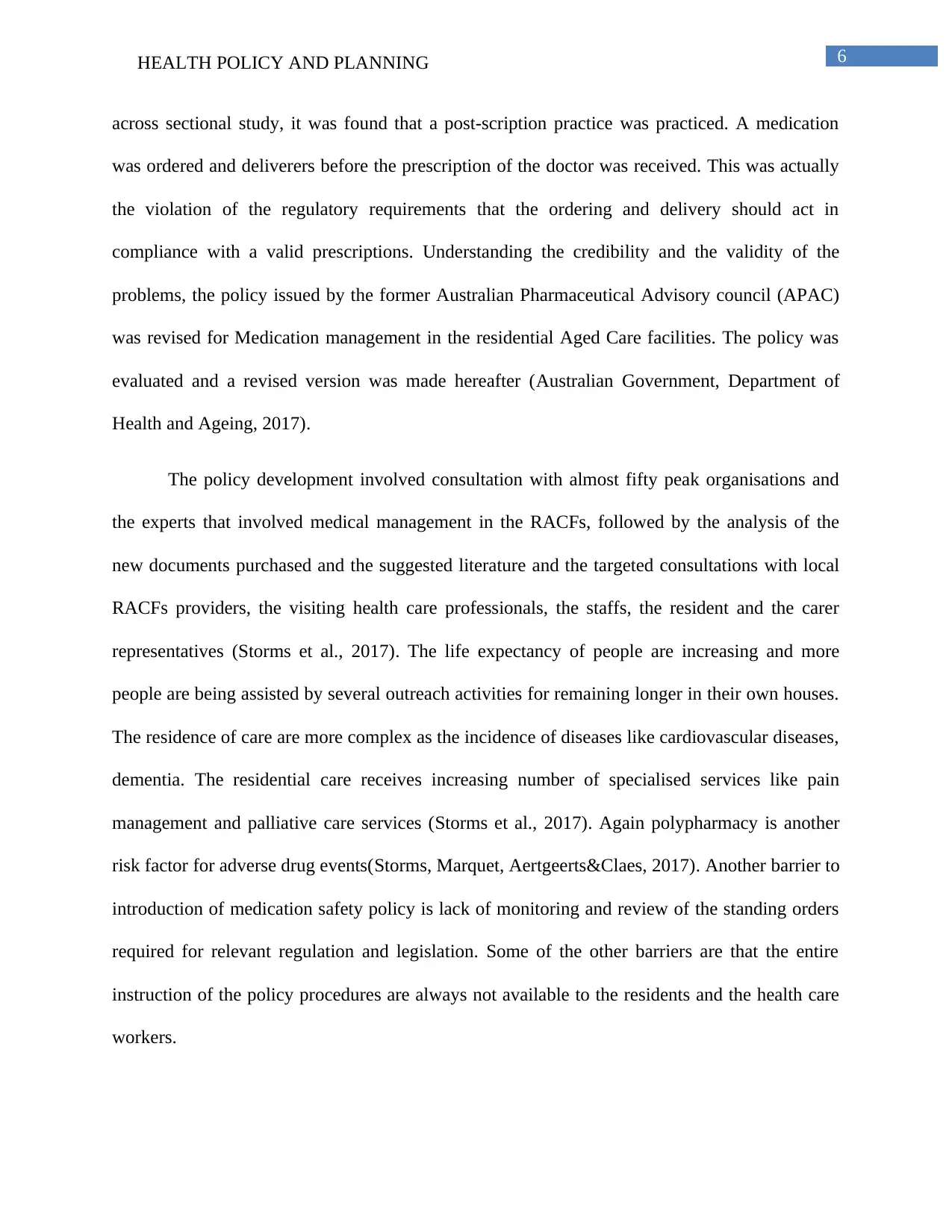
6HEALTH POLICY AND PLANNING
across sectional study, it was found that a post-scription practice was practiced. A medication
was ordered and deliverers before the prescription of the doctor was received. This was actually
the violation of the regulatory requirements that the ordering and delivery should act in
compliance with a valid prescriptions. Understanding the credibility and the validity of the
problems, the policy issued by the former Australian Pharmaceutical Advisory council (APAC)
was revised for Medication management in the residential Aged Care facilities. The policy was
evaluated and a revised version was made hereafter (Australian Government, Department of
Health and Ageing, 2017).
The policy development involved consultation with almost fifty peak organisations and
the experts that involved medical management in the RACFs, followed by the analysis of the
new documents purchased and the suggested literature and the targeted consultations with local
RACFs providers, the visiting health care professionals, the staffs, the resident and the carer
representatives (Storms et al., 2017). The life expectancy of people are increasing and more
people are being assisted by several outreach activities for remaining longer in their own houses.
The residence of care are more complex as the incidence of diseases like cardiovascular diseases,
dementia. The residential care receives increasing number of specialised services like pain
management and palliative care services (Storms et al., 2017). Again polypharmacy is another
risk factor for adverse drug events(Storms, Marquet, Aertgeerts&Claes, 2017). Another barrier to
introduction of medication safety policy is lack of monitoring and review of the standing orders
required for relevant regulation and legislation. Some of the other barriers are that the entire
instruction of the policy procedures are always not available to the residents and the health care
workers.
across sectional study, it was found that a post-scription practice was practiced. A medication
was ordered and deliverers before the prescription of the doctor was received. This was actually
the violation of the regulatory requirements that the ordering and delivery should act in
compliance with a valid prescriptions. Understanding the credibility and the validity of the
problems, the policy issued by the former Australian Pharmaceutical Advisory council (APAC)
was revised for Medication management in the residential Aged Care facilities. The policy was
evaluated and a revised version was made hereafter (Australian Government, Department of
Health and Ageing, 2017).
The policy development involved consultation with almost fifty peak organisations and
the experts that involved medical management in the RACFs, followed by the analysis of the
new documents purchased and the suggested literature and the targeted consultations with local
RACFs providers, the visiting health care professionals, the staffs, the resident and the carer
representatives (Storms et al., 2017). The life expectancy of people are increasing and more
people are being assisted by several outreach activities for remaining longer in their own houses.
The residence of care are more complex as the incidence of diseases like cardiovascular diseases,
dementia. The residential care receives increasing number of specialised services like pain
management and palliative care services (Storms et al., 2017). Again polypharmacy is another
risk factor for adverse drug events(Storms, Marquet, Aertgeerts&Claes, 2017). Another barrier to
introduction of medication safety policy is lack of monitoring and review of the standing orders
required for relevant regulation and legislation. Some of the other barriers are that the entire
instruction of the policy procedures are always not available to the residents and the health care
workers.
Paraphrase This Document
Need a fresh take? Get an instant paraphrase of this document with our AI Paraphraser
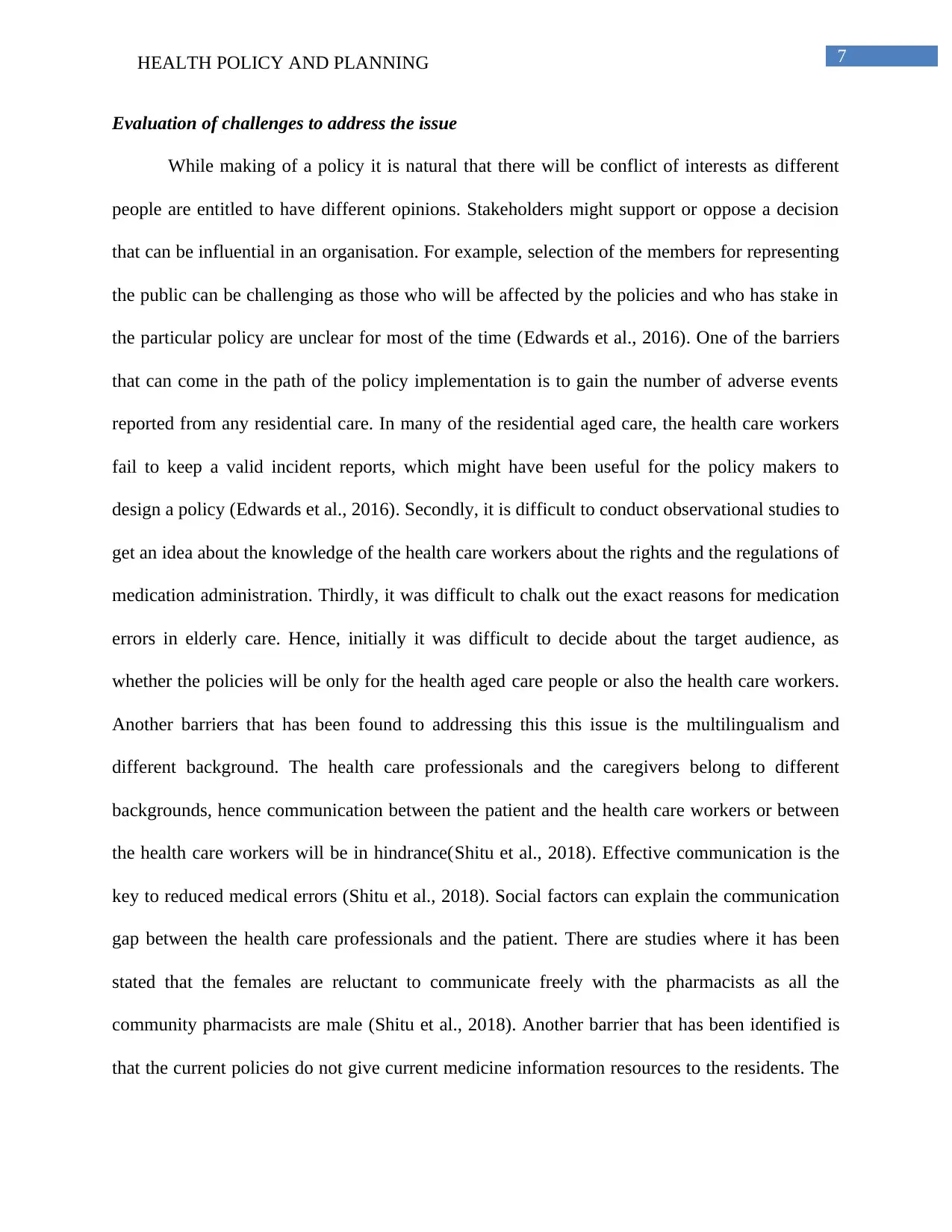
7HEALTH POLICY AND PLANNING
Evaluation of challenges to address the issue
While making of a policy it is natural that there will be conflict of interests as different
people are entitled to have different opinions. Stakeholders might support or oppose a decision
that can be influential in an organisation. For example, selection of the members for representing
the public can be challenging as those who will be affected by the policies and who has stake in
the particular policy are unclear for most of the time (Edwards et al., 2016). One of the barriers
that can come in the path of the policy implementation is to gain the number of adverse events
reported from any residential care. In many of the residential aged care, the health care workers
fail to keep a valid incident reports, which might have been useful for the policy makers to
design a policy (Edwards et al., 2016). Secondly, it is difficult to conduct observational studies to
get an idea about the knowledge of the health care workers about the rights and the regulations of
medication administration. Thirdly, it was difficult to chalk out the exact reasons for medication
errors in elderly care. Hence, initially it was difficult to decide about the target audience, as
whether the policies will be only for the health aged care people or also the health care workers.
Another barriers that has been found to addressing this this issue is the multilingualism and
different background. The health care professionals and the caregivers belong to different
backgrounds, hence communication between the patient and the health care workers or between
the health care workers will be in hindrance(Shitu et al., 2018). Effective communication is the
key to reduced medical errors (Shitu et al., 2018). Social factors can explain the communication
gap between the health care professionals and the patient. There are studies where it has been
stated that the females are reluctant to communicate freely with the pharmacists as all the
community pharmacists are male (Shitu et al., 2018). Another barrier that has been identified is
that the current policies do not give current medicine information resources to the residents. The
Evaluation of challenges to address the issue
While making of a policy it is natural that there will be conflict of interests as different
people are entitled to have different opinions. Stakeholders might support or oppose a decision
that can be influential in an organisation. For example, selection of the members for representing
the public can be challenging as those who will be affected by the policies and who has stake in
the particular policy are unclear for most of the time (Edwards et al., 2016). One of the barriers
that can come in the path of the policy implementation is to gain the number of adverse events
reported from any residential care. In many of the residential aged care, the health care workers
fail to keep a valid incident reports, which might have been useful for the policy makers to
design a policy (Edwards et al., 2016). Secondly, it is difficult to conduct observational studies to
get an idea about the knowledge of the health care workers about the rights and the regulations of
medication administration. Thirdly, it was difficult to chalk out the exact reasons for medication
errors in elderly care. Hence, initially it was difficult to decide about the target audience, as
whether the policies will be only for the health aged care people or also the health care workers.
Another barriers that has been found to addressing this this issue is the multilingualism and
different background. The health care professionals and the caregivers belong to different
backgrounds, hence communication between the patient and the health care workers or between
the health care workers will be in hindrance(Shitu et al., 2018). Effective communication is the
key to reduced medical errors (Shitu et al., 2018). Social factors can explain the communication
gap between the health care professionals and the patient. There are studies where it has been
stated that the females are reluctant to communicate freely with the pharmacists as all the
community pharmacists are male (Shitu et al., 2018). Another barrier that has been identified is
that the current policies do not give current medicine information resources to the residents. The
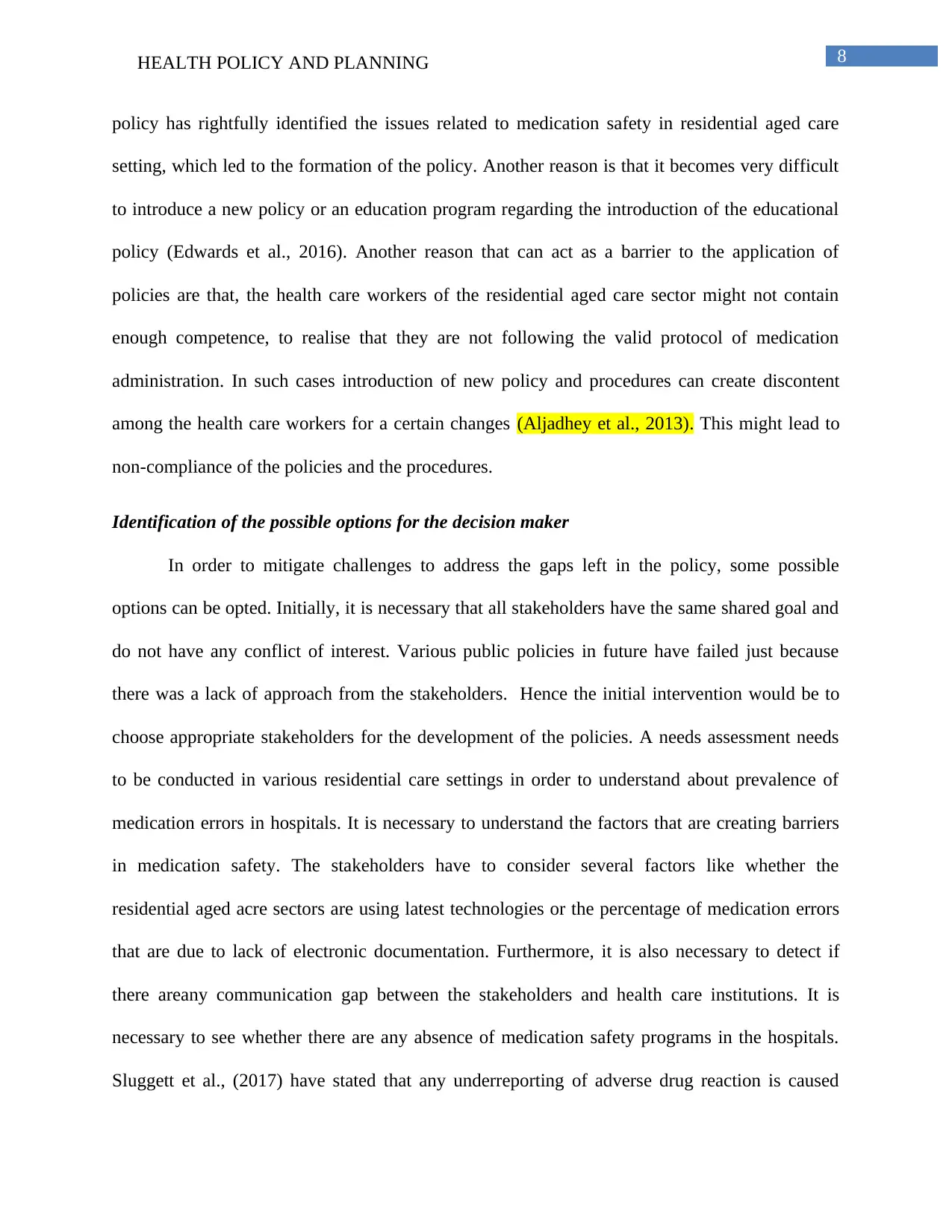
8HEALTH POLICY AND PLANNING
policy has rightfully identified the issues related to medication safety in residential aged care
setting, which led to the formation of the policy. Another reason is that it becomes very difficult
to introduce a new policy or an education program regarding the introduction of the educational
policy (Edwards et al., 2016). Another reason that can act as a barrier to the application of
policies are that, the health care workers of the residential aged care sector might not contain
enough competence, to realise that they are not following the valid protocol of medication
administration. In such cases introduction of new policy and procedures can create discontent
among the health care workers for a certain changes (Aljadhey et al., 2013). This might lead to
non-compliance of the policies and the procedures.
Identification of the possible options for the decision maker
In order to mitigate challenges to address the gaps left in the policy, some possible
options can be opted. Initially, it is necessary that all stakeholders have the same shared goal and
do not have any conflict of interest. Various public policies in future have failed just because
there was a lack of approach from the stakeholders. Hence the initial intervention would be to
choose appropriate stakeholders for the development of the policies. A needs assessment needs
to be conducted in various residential care settings in order to understand about prevalence of
medication errors in hospitals. It is necessary to understand the factors that are creating barriers
in medication safety. The stakeholders have to consider several factors like whether the
residential aged acre sectors are using latest technologies or the percentage of medication errors
that are due to lack of electronic documentation. Furthermore, it is also necessary to detect if
there areany communication gap between the stakeholders and health care institutions. It is
necessary to see whether there are any absence of medication safety programs in the hospitals.
Sluggett et al., (2017) have stated that any underreporting of adverse drug reaction is caused
policy has rightfully identified the issues related to medication safety in residential aged care
setting, which led to the formation of the policy. Another reason is that it becomes very difficult
to introduce a new policy or an education program regarding the introduction of the educational
policy (Edwards et al., 2016). Another reason that can act as a barrier to the application of
policies are that, the health care workers of the residential aged care sector might not contain
enough competence, to realise that they are not following the valid protocol of medication
administration. In such cases introduction of new policy and procedures can create discontent
among the health care workers for a certain changes (Aljadhey et al., 2013). This might lead to
non-compliance of the policies and the procedures.
Identification of the possible options for the decision maker
In order to mitigate challenges to address the gaps left in the policy, some possible
options can be opted. Initially, it is necessary that all stakeholders have the same shared goal and
do not have any conflict of interest. Various public policies in future have failed just because
there was a lack of approach from the stakeholders. Hence the initial intervention would be to
choose appropriate stakeholders for the development of the policies. A needs assessment needs
to be conducted in various residential care settings in order to understand about prevalence of
medication errors in hospitals. It is necessary to understand the factors that are creating barriers
in medication safety. The stakeholders have to consider several factors like whether the
residential aged acre sectors are using latest technologies or the percentage of medication errors
that are due to lack of electronic documentation. Furthermore, it is also necessary to detect if
there areany communication gap between the stakeholders and health care institutions. It is
necessary to see whether there are any absence of medication safety programs in the hospitals.
Sluggett et al., (2017) have stated that any underreporting of adverse drug reaction is caused
⊘ This is a preview!⊘
Do you want full access?
Subscribe today to unlock all pages.

Trusted by 1+ million students worldwide
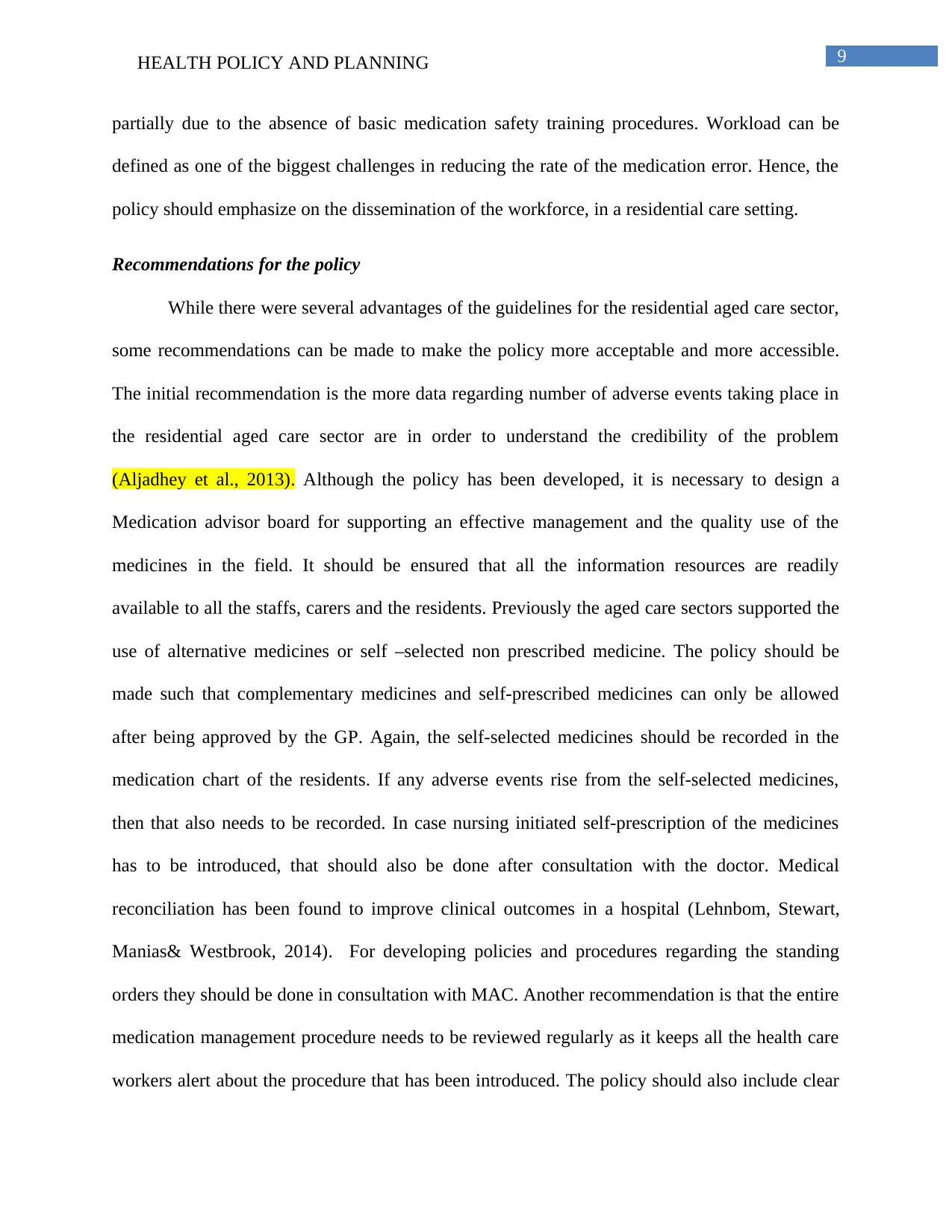
9HEALTH POLICY AND PLANNING
partially due to the absence of basic medication safety training procedures. Workload can be
defined as one of the biggest challenges in reducing the rate of the medication error. Hence, the
policy should emphasize on the dissemination of the workforce, in a residential care setting.
Recommendations for the policy
While there were several advantages of the guidelines for the residential aged care sector,
some recommendations can be made to make the policy more acceptable and more accessible.
The initial recommendation is the more data regarding number of adverse events taking place in
the residential aged care sector are in order to understand the credibility of the problem
(Aljadhey et al., 2013). Although the policy has been developed, it is necessary to design a
Medication advisor board for supporting an effective management and the quality use of the
medicines in the field. It should be ensured that all the information resources are readily
available to all the staffs, carers and the residents. Previously the aged care sectors supported the
use of alternative medicines or self –selected non prescribed medicine. The policy should be
made such that complementary medicines and self-prescribed medicines can only be allowed
after being approved by the GP. Again, the self-selected medicines should be recorded in the
medication chart of the residents. If any adverse events rise from the self-selected medicines,
then that also needs to be recorded. In case nursing initiated self-prescription of the medicines
has to be introduced, that should also be done after consultation with the doctor. Medical
reconciliation has been found to improve clinical outcomes in a hospital (Lehnbom, Stewart,
Manias& Westbrook, 2014). For developing policies and procedures regarding the standing
orders they should be done in consultation with MAC. Another recommendation is that the entire
medication management procedure needs to be reviewed regularly as it keeps all the health care
workers alert about the procedure that has been introduced. The policy should also include clear
partially due to the absence of basic medication safety training procedures. Workload can be
defined as one of the biggest challenges in reducing the rate of the medication error. Hence, the
policy should emphasize on the dissemination of the workforce, in a residential care setting.
Recommendations for the policy
While there were several advantages of the guidelines for the residential aged care sector,
some recommendations can be made to make the policy more acceptable and more accessible.
The initial recommendation is the more data regarding number of adverse events taking place in
the residential aged care sector are in order to understand the credibility of the problem
(Aljadhey et al., 2013). Although the policy has been developed, it is necessary to design a
Medication advisor board for supporting an effective management and the quality use of the
medicines in the field. It should be ensured that all the information resources are readily
available to all the staffs, carers and the residents. Previously the aged care sectors supported the
use of alternative medicines or self –selected non prescribed medicine. The policy should be
made such that complementary medicines and self-prescribed medicines can only be allowed
after being approved by the GP. Again, the self-selected medicines should be recorded in the
medication chart of the residents. If any adverse events rise from the self-selected medicines,
then that also needs to be recorded. In case nursing initiated self-prescription of the medicines
has to be introduced, that should also be done after consultation with the doctor. Medical
reconciliation has been found to improve clinical outcomes in a hospital (Lehnbom, Stewart,
Manias& Westbrook, 2014). For developing policies and procedures regarding the standing
orders they should be done in consultation with MAC. Another recommendation is that the entire
medication management procedure needs to be reviewed regularly as it keeps all the health care
workers alert about the procedure that has been introduced. The policy should also include clear
Paraphrase This Document
Need a fresh take? Get an instant paraphrase of this document with our AI Paraphraser
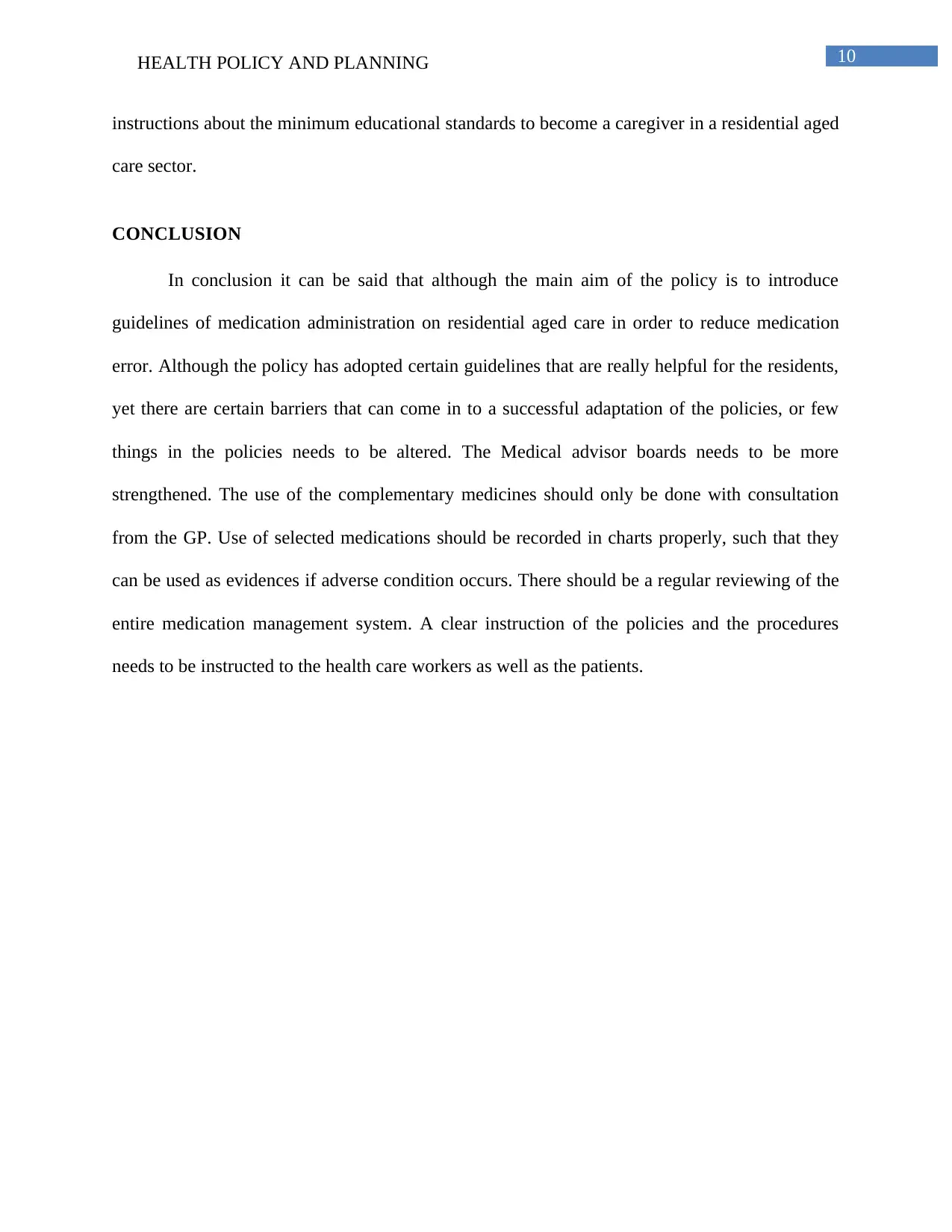
10HEALTH POLICY AND PLANNING
instructions about the minimum educational standards to become a caregiver in a residential aged
care sector.
CONCLUSION
In conclusion it can be said that although the main aim of the policy is to introduce
guidelines of medication administration on residential aged care in order to reduce medication
error. Although the policy has adopted certain guidelines that are really helpful for the residents,
yet there are certain barriers that can come in to a successful adaptation of the policies, or few
things in the policies needs to be altered. The Medical advisor boards needs to be more
strengthened. The use of the complementary medicines should only be done with consultation
from the GP. Use of selected medications should be recorded in charts properly, such that they
can be used as evidences if adverse condition occurs. There should be a regular reviewing of the
entire medication management system. A clear instruction of the policies and the procedures
needs to be instructed to the health care workers as well as the patients.
instructions about the minimum educational standards to become a caregiver in a residential aged
care sector.
CONCLUSION
In conclusion it can be said that although the main aim of the policy is to introduce
guidelines of medication administration on residential aged care in order to reduce medication
error. Although the policy has adopted certain guidelines that are really helpful for the residents,
yet there are certain barriers that can come in to a successful adaptation of the policies, or few
things in the policies needs to be altered. The Medical advisor boards needs to be more
strengthened. The use of the complementary medicines should only be done with consultation
from the GP. Use of selected medications should be recorded in charts properly, such that they
can be used as evidences if adverse condition occurs. There should be a regular reviewing of the
entire medication management system. A clear instruction of the policies and the procedures
needs to be instructed to the health care workers as well as the patients.
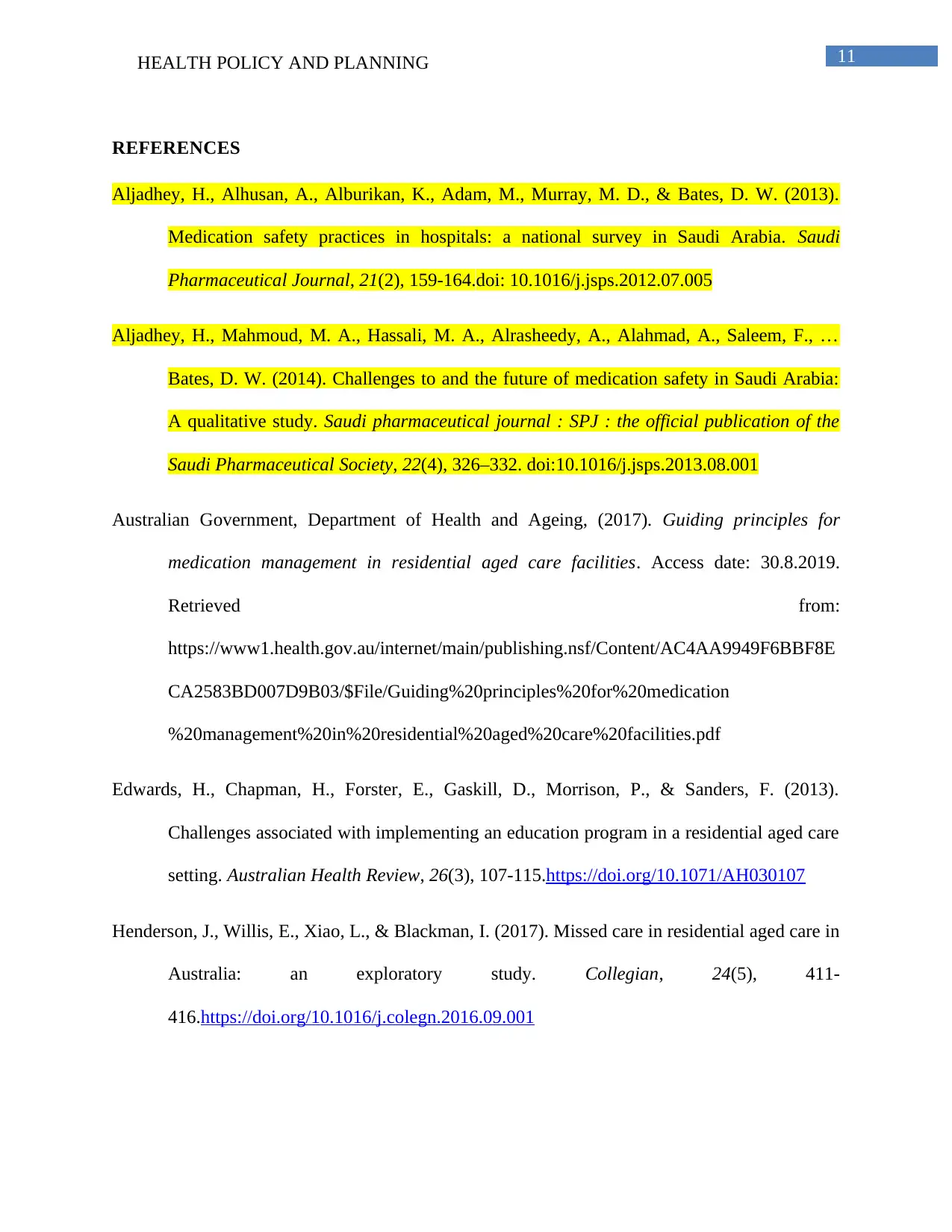
11HEALTH POLICY AND PLANNING
REFERENCES
Aljadhey, H., Alhusan, A., Alburikan, K., Adam, M., Murray, M. D., & Bates, D. W. (2013).
Medication safety practices in hospitals: a national survey in Saudi Arabia. Saudi
Pharmaceutical Journal, 21(2), 159-164.doi: 10.1016/j.jsps.2012.07.005
Aljadhey, H., Mahmoud, M. A., Hassali, M. A., Alrasheedy, A., Alahmad, A., Saleem, F., …
Bates, D. W. (2014). Challenges to and the future of medication safety in Saudi Arabia:
A qualitative study. Saudi pharmaceutical journal : SPJ : the official publication of the
Saudi Pharmaceutical Society, 22(4), 326–332. doi:10.1016/j.jsps.2013.08.001
Australian Government, Department of Health and Ageing, (2017). Guiding principles for
medication management in residential aged care facilities. Access date: 30.8.2019.
Retrieved from:
https://www1.health.gov.au/internet/main/publishing.nsf/Content/AC4AA9949F6BBF8E
CA2583BD007D9B03/$File/Guiding%20principles%20for%20medication
%20management%20in%20residential%20aged%20care%20facilities.pdf
Edwards, H., Chapman, H., Forster, E., Gaskill, D., Morrison, P., & Sanders, F. (2013).
Challenges associated with implementing an education program in a residential aged care
setting. Australian Health Review, 26(3), 107-115.https://doi.org/10.1071/AH030107
Henderson, J., Willis, E., Xiao, L., & Blackman, I. (2017). Missed care in residential aged care in
Australia: an exploratory study. Collegian, 24(5), 411-
416.https://doi.org/10.1016/j.colegn.2016.09.001
REFERENCES
Aljadhey, H., Alhusan, A., Alburikan, K., Adam, M., Murray, M. D., & Bates, D. W. (2013).
Medication safety practices in hospitals: a national survey in Saudi Arabia. Saudi
Pharmaceutical Journal, 21(2), 159-164.doi: 10.1016/j.jsps.2012.07.005
Aljadhey, H., Mahmoud, M. A., Hassali, M. A., Alrasheedy, A., Alahmad, A., Saleem, F., …
Bates, D. W. (2014). Challenges to and the future of medication safety in Saudi Arabia:
A qualitative study. Saudi pharmaceutical journal : SPJ : the official publication of the
Saudi Pharmaceutical Society, 22(4), 326–332. doi:10.1016/j.jsps.2013.08.001
Australian Government, Department of Health and Ageing, (2017). Guiding principles for
medication management in residential aged care facilities. Access date: 30.8.2019.
Retrieved from:
https://www1.health.gov.au/internet/main/publishing.nsf/Content/AC4AA9949F6BBF8E
CA2583BD007D9B03/$File/Guiding%20principles%20for%20medication
%20management%20in%20residential%20aged%20care%20facilities.pdf
Edwards, H., Chapman, H., Forster, E., Gaskill, D., Morrison, P., & Sanders, F. (2013).
Challenges associated with implementing an education program in a residential aged care
setting. Australian Health Review, 26(3), 107-115.https://doi.org/10.1071/AH030107
Henderson, J., Willis, E., Xiao, L., & Blackman, I. (2017). Missed care in residential aged care in
Australia: an exploratory study. Collegian, 24(5), 411-
416.https://doi.org/10.1016/j.colegn.2016.09.001
⊘ This is a preview!⊘
Do you want full access?
Subscribe today to unlock all pages.

Trusted by 1+ million students worldwide
1 out of 13
Related Documents
Your All-in-One AI-Powered Toolkit for Academic Success.
+13062052269
info@desklib.com
Available 24*7 on WhatsApp / Email
![[object Object]](/_next/static/media/star-bottom.7253800d.svg)
Unlock your academic potential
Copyright © 2020–2025 A2Z Services. All Rights Reserved. Developed and managed by ZUCOL.




